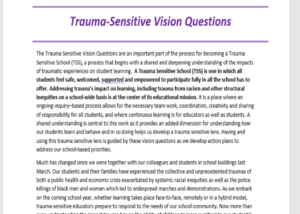QUESTION 3:What actions will address staff priorities and help us become a Trauma-Sensitive School?
Schools address this question by engaging in the following activities:
1. Identifying trauma-sensitive actions steps to address staff’s priorities
Trauma-Sensitive Vision Questions
 The Trauma Sensitive Vision Questions are an important part of the process for becoming a Trauma Sensitive School (TSS), a process that begins with a shared and deepening understanding of the impacts of traumatic experiences on student learning. A Trauma Sensitive School (TSS) is one in which all students feel safe, welcomed, supported and empowered to participate fully in all the school has to offer. Addressing trauma’s impact on learning, including trauma from racism and other structural inequities on a school-wide basis is at the center of its educational mission. It is a place where an ongoing inquiry–based process allows for the necessary team work, coordination, creativity and sharing of responsibility for all students, and where continuous learning is for educators as well as students. A shared understanding is central to this work as it provides an added dimension for understanding how our students learn and behave and in so doing helps us develop a trauma sensitive lens. Having and using this trauma sensitive lens is guided by these vision questions as we develop action plans to address our school-based priorities.
The Trauma Sensitive Vision Questions are an important part of the process for becoming a Trauma Sensitive School (TSS), a process that begins with a shared and deepening understanding of the impacts of traumatic experiences on student learning. A Trauma Sensitive School (TSS) is one in which all students feel safe, welcomed, supported and empowered to participate fully in all the school has to offer. Addressing trauma’s impact on learning, including trauma from racism and other structural inequities on a school-wide basis is at the center of its educational mission. It is a place where an ongoing inquiry–based process allows for the necessary team work, coordination, creativity and sharing of responsibility for all students, and where continuous learning is for educators as well as students. A shared understanding is central to this work as it provides an added dimension for understanding how our students learn and behave and in so doing helps us develop a trauma sensitive lens. Having and using this trauma sensitive lens is guided by these vision questions as we develop action plans to address our school-based priorities.
2. Developing a school-wide action plan
BLOGS:
 The Flexible FrameworkThe Flexible Framework - Creating an Action Plan for a Trauma-Sensitive School is an organizational tool that is designed to enable schools to develop their own trauma-sensitive institutional structure. It provides guidelines for establishing schoolwide practices.
The Flexible FrameworkThe Flexible Framework - Creating an Action Plan for a Trauma-Sensitive School is an organizational tool that is designed to enable schools to develop their own trauma-sensitive institutional structure. It provides guidelines for establishing schoolwide practices.
The Framework is organized according to six core operational functions of schools, each of which is critical to any effort that seeks to make school-wide changes. We recommend educators carefully consider the role of each element as they create action plans.
As the steering committee moves toward action planning, it is important to determine which of the priorities the school should address first. Though there may be several pressing concerns, key to success is choosing one or two priorities that are achievable to start addressing.
It may be helpful to consider
-
Which of the priorities is most pressing?
-
Which seem achievable in the short-term?
-
Which of the priorities will lead us closer to our goal of becoming more trauma-sensitive?
The goal of this first action plan is to leverage the greatest amount of improvement for students while ensuring that the staff feel the satisfaction that comes from seeing short-term, concrete results. As the action planning process is used over time, schools will be able to address additional priorities.
 Here we share another set of questions as a useful tool for creating a successful Action Plan: the Flexible Framework Questions. Once the school’s steering committee has identified its major actions, answering the Flexible Framework Questions will ensure that trauma-sensitivity weaves throughout all of the school’s core operations. These questions are designed to support whole-school culture change by helping educators “cover the bases” and ensure that trauma sensitivity is infused into each aspect of the school. The questions inquire about six familiar and important school operations that educators should keep in mind as they implement trauma-sensitivity school-wide.
Here we share another set of questions as a useful tool for creating a successful Action Plan: the Flexible Framework Questions. Once the school’s steering committee has identified its major actions, answering the Flexible Framework Questions will ensure that trauma-sensitivity weaves throughout all of the school’s core operations. These questions are designed to support whole-school culture change by helping educators “cover the bases” and ensure that trauma sensitivity is infused into each aspect of the school. The questions inquire about six familiar and important school operations that educators should keep in mind as they implement trauma-sensitivity school-wide.
 A critical component of creating a safe and supportive school is giving thoughtful consideration to making sure that when needed, students and families have access to culturally, linguistically, clinically, age and developmentally appropriate services that are integrated into a welcoming school culture. A safe and supportive school culture promotes a sense of safety and belonging, nurtures relationships, fosters students’ ability to regulate emotions and behaviors, supports health and well-being, and enhances academic development. Effectively integrating services and supports into a school requires a school infrastructure where school-based student support staff and community providers can work collaboratively, confidentially, and in a coordinated way.
A critical component of creating a safe and supportive school is giving thoughtful consideration to making sure that when needed, students and families have access to culturally, linguistically, clinically, age and developmentally appropriate services that are integrated into a welcoming school culture. A safe and supportive school culture promotes a sense of safety and belonging, nurtures relationships, fosters students’ ability to regulate emotions and behaviors, supports health and well-being, and enhances academic development. Effectively integrating services and supports into a school requires a school infrastructure where school-based student support staff and community providers can work collaboratively, confidentially, and in a coordinated way.
3. Planning for how to track the school’s progress toward trauma-sensitivity.
Some trauma-sensitive schools have found that surveying all staff at the end of each school year to gather their feedback on that year’s action steps informs the steering committee’s on-going work.
Part 3: Visions of a Trauma-Sensitive School Questions
Question 1: Why do we feel an urgency to become a trauma-sensitive school?
Question 2: How do we know we are ready to create a Trauma-Sensitive Action Plan?
Question 3: What actions will address staff priorities and help us become a Trauma-Sensitive School?
Question 4: How do we know we are becoming a Trauma-Sensitive School?